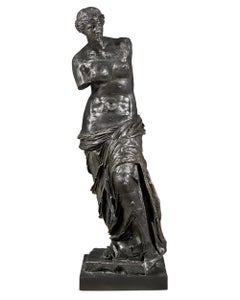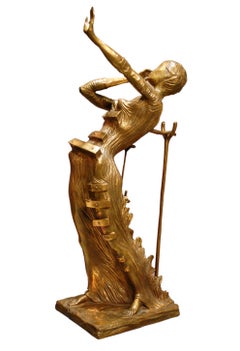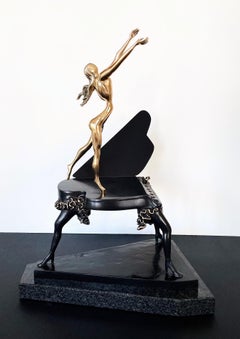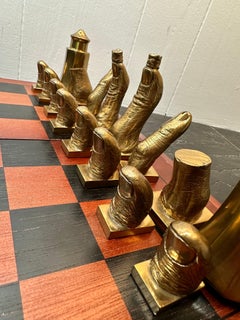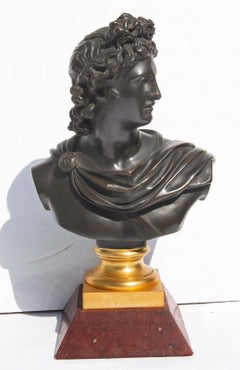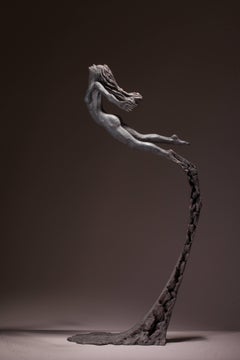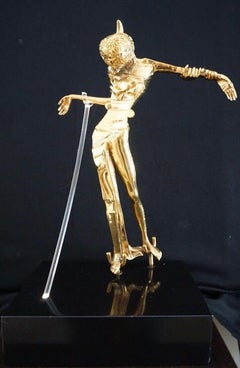Bronze Figurative Sculptures
to
1
11
2
8
2
2
1
Overall Height
to
Overall Width
to
11
1
9
7
5
4
4
2
1
1
1
1
1
1
1
1
13
7
1
3
1,055
101
96
82
72
17
13
4
2
2
Artist: Salvador Dalí
Medium: Bronze
Vénus De Milo Aux Tiroirs By Salvador Dalí
Located in New Orleans, LA
Salvador Dalí
1904-1989 Spanish
Vénus de Milo aux tiroirs
(Venus de Milo with drawers)
Signed "Salvador Dalí EA III/IV" (on base)
Bronze
One of th...
Category
20th Century Post-Impressionist Bronze Figurative Sculptures
Materials
Bronze
Alma del Quijote - The Soul of Don Quixote
Located in Hollywood, FL
ARTIST: Salvador Dali
TITLE: Alma del Quijote - also know as The Soul of Don Quixote
MEDIUM: Bronze sculpture on a marble base
SIGNED: Engraved signature in the sculpture
EDITIO...
Category
1960s Surrealist Bronze Figurative Sculptures
Materials
Bronze
Woman Aflame Salvador Dali 1980
Located in Lake Worth Beach, FL
Salvador Dali Femme En FLamme Woman Aflame
Artist signed in the mold, edition 141/350 Edition of 350 + 35AP
stamped 'Venturi Arte' and Camblest 1981
Edi...
Category
1980s Surrealist Bronze Figurative Sculptures
Materials
Bronze
Piano surréaliste, Salvador Dali
Located in Fairfield, CT
Artist: Salvador Dali (1904-1989)
Title: Piano surréaliste
Year: 1984
Medium: Bronze
Edition: 34/350, plus proofs
Size: 26.3 x 15.7 x 12 inches
Condition: Excellent
Inscription: Inci...
Category
1980s Surrealist Bronze Figurative Sculptures
Materials
Bronze
Dali Chess Set
Located in Wilton, CT
Set of 32 polished and patinated-bronze chess pieces, 1966-70. Height varies from 38 mm; 1 1/2 inches to 85mm; 3 3/8 inches. Each piece signed on t...
Category
1960s Surrealist Bronze Figurative Sculptures
Materials
Bronze
Rare 1966 Original Bronze Sculpture "The Two Nikes" edition of 6 Salvador Dali
Located in Surfside, FL
Salvador Dali (1904-1989) – The Two Nikes, Lilith, The Double Victory of Samothrace, Homage to Raymond Roussel
Literature: Descharnes, Robert, Salvador Dalí, and Nicolas Descharnes. "Dalí, the hard and the soft: spells for the magic of form : sculptures & objects." (Azay-le-Rideau: Eccart, 2004), p, 114 (entry 270).
Rare original bronze from edition of 6. This is exceedingly rare as most of his editions run into the hundreds. this is a true authentic Dali original sculpture.
This was recently authenticated and comes accompanied by a Report of Authenticity from Frank Hunter, the Director of the Salvador Dalí Archives.
Löpsinger 270
Executed in 1966, this bronze statue is incised with the artist’s signature and numbered ‘5/6’ on base. Published by Berrocal Foundry, the work measures 7 3/8 inches in height.
Salvador Dalí (Spanish, 1904-1989)
A leading proponent of Surrealism, Salvador Dalí is perhaps as well-known for his flamboyant personality as his superb technical skill. Dalí became acquainted with André Breton, a key figure of the Surrealist movement, in 1929. “The Persistence of Memory” is often cited as the most important work of this style. The Museum of Modern Art, New York, held a retrospective of the artist’s work in 1941. The next year, he began a more classical series of paintings, incorporating history, science and religion. In addition to painting, Dalí also made prints, photographs, films, jewelry and sculpture. His works can be found in collections worldwide, including the National Gallery, Washington, DC and the Salvador Dalí Museum.
In 1928 Dali went to Paris where he met the Spanish painters Pablo Picasso and Joan Miro. He established himself as the principal figure of a group of surrealist artists grouped around Andre Breton, who was something like the theoretical "schoolmaster" of surrealism. Years later Breton turned away from Dali accusing him of support of fascism, excessive self-presentation and financial greediness.
By 1929 Dali had found his personal style that should make him famous - the world of the unconscious that is recalled during our dreams. The surrealist theory is based on the theories of the psychologist Dr. Sigmund Freud. Recurring images of burning giraffes and melting watches...
Category
1960s Surrealist Bronze Figurative Sculptures
Materials
Bronze
Masque de Napoléon sur un Rhinocéros, Sculpture, Dali, Gold, Animals, Bronze
Located in Geneva, CH
Masque de Napoléon sur un Rhinocéros, Sculpture, Dali, Gold, Animals, Bronze
Masque mortuaire de Napoléon sur un rhinoceros
Ed. 7/8 pcs
Bronze with golden patina
32.5 x 30 x 18.5 cm
Signed, numbered and foundry's stamp : 7/8 , Valsuani
Dalì, Sculpture & Objets, Le dur et le mou, by Robert and Nicolas Descharnes, Eccart, 2004, similar cast illustrated under no.359-361, p.140.
Fascinated since his childhood by Vermeer’s painting...
Category
20th Century Dada Bronze Figurative Sculptures
Materials
Bronze
Dali - De Draeger - Portfolio Luxury edition - 1968
Located in Collonge Bellerive, Geneve, CH
Dali -De Draeger, Portfolio by Max Gérard
Luxury edition inside special packaged box bearing a cover with “soft melting pocket watch” and bronze medal of “L'Unicorne Dyonisiaque” minted and numbered by Monnaie de Paris...
Category
1960s Surrealist Bronze Figurative Sculptures
Materials
Bronze
Woman with Head of Roses, Surrealist Bronze Sculpture by Salvador Dali
Located in Long Island City, NY
"Woman with Head of Roses" or "Femme à Tête de Roses" is a bronze sculpture by Surrealist Salvador Dali. This interesting piece, referenced by Descharnes as number 684, includes a pl...
Category
1980s Surrealist Bronze Figurative Sculptures
Materials
Bronze
Don Quixote Bas Relief in Original Velvet Box
Located in Missouri, MO
"Don Quixote" 1979
Bronze (encased in original velvet box)
Signed Lower right
Numbered Lower Left 157/215
Size of Relief: 27" x 18.5"
Size of Velvet box: 29.5" x 21" x 3.25"
Provenance: Martin Lawrence Galleries
Salvador Felipe Jacinto Dali was born May 11, 1904 in the small Spanish town of Figueras in the province of Catalunya. The name 'Salvador' had been given to an older brother who died in infancy. When Dali was born the name was passed on to him. No one could have known just how revolutionary and important this name would become to the art world. Growing up, Dali was a difficult child and refused to conform to family or community customs. Dali's father, a respected notary, his mother and younger sister all encouraged Dali's early interest in art. In fact, a room in the family home was the young artist's first studio. Early on, Dali's talent was already refined beyond his years, and with each year his talent only grew, as did his interests.
After receiving private art lessons in Figueras for some time, Dali enrolled at the Escuela de Pintura, Escultura y Grabado de Bellas Artes de San Fernando in Madrid in 1921. There he joined an avant-garde circle of students that included film-maker Luis Bunuel and poet-dramatist Federico Garcia Lorca. Although Dali excelled in his academic pursuits, he never took final examinations, deeming that he had no need for the type of education offered by formal schooling. He was expelled and reinstated, yet it mattered little to him. Salvador Dali's passion for the arts and his need to experience life on his own terms could not be met within the confines of school. He left. This did not sit well with Dali's father however, and Salvador was subsequently disowned. With no true home left to him, Dali moved into a fisherman's shack in the small village of Port Lligat, two miles from Cadaques and not far from the French border. Port Lligat would become the site of Dali's future mansion home where he would spend many years of his life.
It was at this time that Dali came under the influence of two forces that shaped his philosophy and his art. The first was Sigmund Freud's theory of the unconscious, introduced to Dali in Freud's book The Interpretation of Dreams. The second was his association with the French surrealists, a group of artists and writers led by the French poet Andre Breton. When Dali visited Paris for the first time, he was introduced to the leading surrealists in the movement, but because of his lack of interest in politics, he was eventually shunned by this group.
It was also around this time that Dali met the woman who was to become one the most important people in his life... his wife and soul mate, Gala. Gala was a Russian girl...
Category
1970s Surrealist Bronze Figurative Sculptures
Materials
Bronze
Bust of John F. Kennedy
Located in Long Island City, NY
This iconoclastic sculpture links two of the twentieth century’s most renowned figures: President John Fitzgerald Kennedy and Salvador Dalí. Cast in wax and decorated with paperclip...
Category
1960s Surrealist Bronze Figurative Sculptures
Materials
Bronze
The Michelin Slave
Located in Long Island City, NY
Artist: Salvador Dali, Spanish (1904 - 1989)
Title: The Michelin Slave
Year: 1967
Medium: Bronze Sculpture, Signature and number inscribed
Edition: 5/6
Size: 12 in x 6 in d. (...
Category
1960s Surrealist Bronze Figurative Sculptures
Materials
Bronze
Swan-Elephant
Located in Long Island City, NY
Artist: Salvador Dali, Spanish (1904 - 1989)
Title: Swan-Elephant
Year: 1967
Medium: Bronze Sculpture, Signature and number inscribed
Edition: 5/6
Size: 4.5 in. x 8 in. x 5.5 i...
Category
1960s Surrealist Bronze Figurative Sculptures
Materials
Bronze
Related Items
Bronze Bust of Apollo Belvedere Grand Tour 19th Century
Located in Rochester, NY
Superb 19th century bronze and gilt bronze bust of the god Belvedere Apollo. Circa 1850. This wonderful grand tour bust is a marvel of refined beauty and elegance, crafted with richl...
Category
19th Century Bronze Figurative Sculptures
Materials
Marble, Bronze
Ian Edwards - Leap Within Faith - Original Signed Bronze Sculpure
By Ian Edwards
Located in Collonge Bellerive, Geneve, CH
Ian Edwards - Leap Within Faith - Original Signed Bronze Sculpure
Dimensions: 170 x 55 x 40 cm
Edition of 12
Edwards’ practice expresses the power and determination of human endea...
Category
2010s Contemporary Bronze Figurative Sculptures
Materials
Bronze
H 66.93 in W 21.66 in D 15.75 in
Ian Edwards - Born within Fire - Original Signed Bronze Sculpure
By Ian Edwards
Located in Collonge Bellerive, Geneve, CH
Ian Edwards - Born within Fire - Original Signed Bronze Sculpure
Dimensions: 160 x 60 x 60 cm
Edition of 12
Edwards’ practice expresses the power and determination of human endeav...
Category
2010s Contemporary Bronze Figurative Sculptures
Materials
Bronze
H 63 in W 23.63 in D 23.63 in
"At Last, " Sculpture
By Bill Starke
Located in Denver, CO
Bill Starke's "At Last" is a limited edition, bronze sculpture created by Bill Starke depicting a male figure with out-stretched arms.
( 3/85 )
About the artist:
Human beings int...
Category
2010s Realist Bronze Figurative Sculptures
Materials
Marble, Bronze
Statue of Athlete: Large Academic Style Bronze Figurative Sculpture of Nude Male
By Mark Beard
Located in Hudson, NY
modern figurative bronze sculpture of a nude athlete
8.5 feet tall and measures 36 inches at the widest point
bottom base measures ...
Category
Early 2000s Academic Bronze Figurative Sculptures
Materials
Bronze
H 102 in W 36.5 in D 17.5 in
Mathurin Moreau "La Source" Bronze and Breccia Pernice Marble Sculpture
Located in New York, NY
A gilt bronze Female figural sculpture depicting a young woman, slightly unveiled, sitting atop a variegated marble fountain, fitted atop a squared bronze base decorated with foliage...
Category
19th Century Bronze Figurative Sculptures
Materials
Marble, Bronze
H 26.6 in W 14 in D 10 in
Gold Hand Chair
Located in San Miguel de Allende, Guanajuato
Pedro Friedeberg
Gold Hand Chair.
Gold leaf over wood.
Signed inside the base.
Includes certificate of authenticity signed by the artist.
Available a...
Category
1960s Surrealist Bronze Figurative Sculptures
Materials
Gold Leaf
Nude Female Torso Bronze Sculpture, 20th Century Contemporary American Artist
Located in Beachwood, OH
Alan Cottrill (American, Ohio, b. 1952)
Nude Female Torso, 1994
Bronze mounted to green marble base
Signed, dated and numbered 14/20 verso of leg, with foundry stamp
17. in. h. x 6 i...
Category
1990s Bronze Figurative Sculptures
Materials
Marble, Bronze
Last Heroic Season Bronze Sculpture Classic Contemporary Mythology
By Margot Homan
Located in Utrecht, NL
Last Heroic Season Bronze Sculpture Classic Contemporary Mythology
The sculptures of Margot Homan (1956, Oss, the Netherlands) show a perfect command of the old craft of modelling a...
Category
21st Century and Contemporary Contemporary Bronze Figurative Sculptures
Materials
Bronze
Free Shipping
H 98.43 in W 19.69 in
Dionysisch Big Bronze Sculpture Mythology Classical Contemporary Art
By Margot Homan
Located in Utrecht, NL
Dionysisch Big Bronze Sculpture Mythology Classical Contemporary Art
The sculptures of Margot Homan (1956, Oss, NL) show a perfect command of the...
Category
21st Century and Contemporary Contemporary Bronze Figurative Sculptures
Materials
Bronze
Free Shipping
H 78.75 in W 29.53 in
Satyr with Cymbals and Kroupezion, Grand Tour after the Antique, 19th century
Located in Beachwood, OH
19TH CENTURY CONTINENTAL SCHOOL
Satyr with Cymbals and Kroupezion, Grand Tour after the Antique
Bronze with marble base
26 in. h. x 15 in. w. x 10 in. d.
This dancing faun is now mo...
Category
19th Century Bronze Figurative Sculptures
Materials
Marble, Bronze
H 26 in W 15 in D 10 in
Dali - De Draeger - Portfolio Luxury edition - 1968
Located in Collonge Bellerive, Geneve, CH
Dali -De Draeger, Portfolio by Max Gérard
Luxury edition inside special packaged box bearing a cover with “soft melting pocket watch” and bronze medal of “L'Unicorne Dyonisiaque” minted and numbered by Monnaie de Paris...
Category
1960s Surrealist Bronze Figurative Sculptures
Materials
Bronze
Previously Available Items
Head of Roses Sculpture
Located in Hollywood, FL
ARTIST: Salvador Dali
TITLE: Head of Roses With Light Up Crutch
MEDIUM: Sculpture with Light Up Crutch
SIGNED: Signed in the sculpture
EDITION NUMBER: 198/350
MEASUREMENTS: H- ...
Category
Late 20th Century Surrealist Bronze Figurative Sculptures
Materials
Bronze
Cybele/Earth Mother Sculpture
Located in Hollywood, FL
This is a bronze sculpture with brown patina. The edition number is 5/100. It is inscribed Dali and numbered on the lower right edge. Reference: Sculptures & Objects The Hard and ...
Category
1970s Surrealist Bronze Figurative Sculptures
Materials
Bronze
Black Horseman - Original Bronze Sculpture, Signed (Descharnes #513)
Located in Paris, FR
Salvador Dali
Black Horseman, 1977
Original bronze sculpture (lost wax technic)
Signed and dated in the sculpture
Numbered / 150
Bearing the founder stamp (Airaindor)
Bronze c. 46 x...
Category
1970s Surrealist Bronze Figurative Sculptures
Materials
Bronze
Salvador Dali "Alice au Pays des Merveilles",
Located in Los Angeles, CA
Salvador Dali (1904-1989)
"Alice au Pays des Merveilles",
Bronze sculpture
89.4H x 48W x 20.5cm, incised with signature underneath, ed.350, with foundry mark © JEMELTON 1984) and ...
Category
1980s Bronze Figurative Sculptures
Materials
Bronze
"Dance of Time III" limited edition bronze table sculpture soft pocket watch
Located in Kowloon, Hong Kong
The soft pocket watch is the most recognizable Dalinian image and the artist chose to portray it consistently throughout his lifetime. Dalí became obsessed with the concept of time and used the this image in many of his works. Dalí brings to this sculpture a dynamism, where the watch appears to be literally “dancing”. Unrestrained by the rigid laws of a watch, time, for Dalí, moves to the rhythm of a perpetual dance, speeding up, slowly down, stretching out, liquefying. The watch illustrates an important theme in Dalí’s art;the contrast between the hard and the soft, a central preoccupation of the artist. Dalí flips reality, taking the familiar image of a watch which is hard, solid and precise and inverts its characteristics. It is now the opposite, becoming soft, inaccurate, time bends to individual meanings. Again in this sculpture, the unexpected softness of the watch contrasts with the hardened sturdy tree trunk upon which the clock rests. Some say that Dalí represents in his watches Albert Einstein’s theory of relativity of space and time; the dancing watch illustrating the concept of movement through time.
Date: conceived in 1979 and first cast in 1984
Technique: lost wax process
Edition size: 350 + 35 EA (artist proof)
Patina: green
Maquette: original gouache, ʺDance of Timeʺ, 1979
Foundry: Perseo
Descharnes References: Dalí: The Hard and the Soft, Sculptures & Objects. Eccart, 2004. pg. 248 ref. 638
Authenticity: Artist signed in the mold, Foundry Certificate and Editor/Dealer Certificate*
*Both Mr. A. Reynolds Morse, President and Founder of the Salvador Museum in Florida (now deceased), and Mr. Robert Descharnes (now deceased), world renowned Dalí expert and author of the only catalogue raisonée of Salvador Dalí sculpture, have officially written their comments exclusively for use on the certificate.
BIOGRAPHY OF ARTIST
Salvador Dali was born in May, 1904 in the small agricultural town of Figueres, Spain. The son of a prosperous notary. The young Dali attended the San Fernando Academy of Fine Arts in Madrid. Early recognition of Dali’s talent came with his first one-man show in Barcelona in 1925. Dali held his first one-man show in Paris in 1926 where he also joined the surrealists, led by former Dadaist Andre Breton.
Dali soon became a leader of the Surrealist Movement. His painting, The Persistance of Memory...
Category
1980s Surrealist Bronze Figurative Sculptures
Materials
Bronze
Free Shipping
H 10.44 in W 7.49 in D 8.08 in
"Dance of Time III" limited edition bronze table sculpture soft pocket watch
Located in Kowloon, Hong Kong
The soft pocket watch is the most recognizable Dalinian image and the artist chose to portray it consistently throughout his lifetime. Dalí became obsessed with the concept of time and used the this image in many of his works. Dalí brings to this sculpture a dynamism, where the watch appears to be literally “dancing”. Unrestrained by the rigid laws of a watch, time, for Dalí, moves to the rhythm of a perpetual dance, speeding up, slowly down, stretching out, liquefying. The watch illustrates an important theme in Dalí’s art;the contrast between the hard and the soft, a central preoccupation of the artist. Dalí flips reality, taking the familiar image of a watch which is hard, solid and precise and inverts its characteristics. It is now the opposite, becoming soft, inaccurate, time bends to individual meanings. Again in this sculpture, the unexpected softness of the watch contrasts with the hardened sturdy tree trunk upon which the clock rests. Some say that Dalí represents in his watches Albert Einstein’s theory of relativity of space and time; the dancing watch illustrating the concept of movement through time.
Date: conceived in 1979 and first cast in 1984
Technique: lost wax process
Edition size: 350 + 35 EA (artist proof)
Patina: green
Maquette: original gouache, ʺDance of Timeʺ, 1979
Foundry: Perseo
Descharnes References: Dalí: The Hard and the Soft, Sculptures & Objects. Eccart, 2004. pg. 248 ref. 638
Authenticity: Artist signed in the mold, Foundry Certificate and Editor/Dealer Certificate*
*Both Mr. A. Reynolds Morse, President and Founder of the Salvador Museum in Florida (now deceased), and Mr. Robert Descharnes (now deceased), world renowned Dalí expert and author of the only catalogue raisonée of Salvador Dalí sculpture, have officially written their comments exclusively for use on the certificate.
BIOGRAPHY OF ARTIST
Salvador Dali was born in May, 1904 in the small agricultural town of Figueres, Spain. The son of a prosperous notary. The young Dali attended the San Fernando Academy of Fine Arts in Madrid. Early recognition of Dali’s talent came with his first one-man show in Barcelona in 1925. Dali held his first one-man show in Paris in 1926 where he also joined the surrealists, led by former Dadaist Andre Breton.
Dali soon became a leader of the Surrealist Movement. His painting, The Persistance of Memory...
Category
1980s Surrealist Bronze Figurative Sculptures
Materials
Bronze
Free Shipping
H 10.44 in W 7.49 in D 8.08 in
"Triumphant Angel" limited edition bronze figurative table sculpture surrealism
Located in Kowloon, Hong Kong
Religious imagery fascinated and intrigued Dalí throughout his lifetime. For Dalí, angels expressed grace, nobility and lightness. Dalí once said “nothing is more stimulating than the idea of an angel!”. The face and trumpet in the sculpture, echo the Cubist style pioneered by Pablo Picasso, who Dalí admired. It is interesting that Cubism and Surrealism co-exist in this sculpture.
From the 1940s, when Dalí began weaving strong religious themes into his artworks, angels appear frequently in his oeuvre. Dalí rejected his family’s Catholicism early in life, only to re-embrace it again in later years. For Dalí, angels represented divine awareness, purity, protection and illumination. The key element of the sculpture is the trumpet, it links heaven and earth, bringing and reflecting divine light. The angel’s wings are in perfect equilibrium, referencing Dalí’s obsession with geometrical precision. This sculpture embodies Dalí’s idea of heavenly achievement and aspiration.
Date: conceived 1976 and first cast in 1984
Technique: lost wax process
Edition size: 350 + 35 EA (artist proof)
Patina: blue
Maquette: original drawing, ʺTriumphant Angelʺ, 1976
Foundry: Perseo
Descharnes References: Dalí: The Hard and the Soft, Sculptures & Objects. Eccart, 2004. pg. 254 ref. 652
Authenticity: Artist signed in the mold, Foundry Certificate and Editor/Dealer Certificate*
*Both Mr. A. Reynolds Morse, President and Founder of the Salvador Museum in Florida (now deceased), and Mr. Robert Descharnes (now deceased), world renowned Dalí expert and author of the only catalogue raisonée of Salvador Dalí sculpture, have officially written their comments exclusively for use on the certificate.
BIOGRAPHY OF ARTIST
Salvador Dali was born in May, 1904 in the small agricultural town of Figueres, Spain. The son of a prosperous notary. The young Dali attended the San Fernando Academy of Fine Arts in Madrid. Early recognition of Dali’s talent came with his first one-man show in Barcelona in 1925. Dali held his first one-man show in Paris in 1926 where he also joined the surrealists, led by former Dadaist Andre Breton.
Dali soon became a leader of the Surrealist Movement. His painting, The Persistance of Memory...
Category
1980s Surrealist Bronze Figurative Sculptures
Materials
Bronze
Free Shipping
H 19.69 in W 6.7 in D 7.09 in
"Profile of Time" limited edition bronze table sculpture soft pocket watch green
Located in Kowloon, Hong Kong
Echoing Dalí's 1931 painting The Persistence of Memory, in which the famous melted watch appears for the first time, this sculpture is an ingenious creation - full of symbolism and hidden meanings. Dalí became obsessed with the flow of time and portrays the watch as soft, a type of symbolism he reserved for those objects he loathed. “The mechanical object was to become my worst enemy, and as for watches, they would have to be soft, or not be at all!”
The soft watch liquefies lamentably over the tree forming a double image. Tilting ones head to the left a hidden image appears; the watch face changes into the artists profile, an eye, a pointed nose and the 9 suggestive of Dalí’s moustache. Dalí enjoyed surprising people and encouraged them to participate in his art.
The shape of limp clock immediately recalls Dalí’s 1929 work The Great Masturbator, a self-portrait with a distorted long head in profile looking downward. This peculiar shape is based on a specific rock formation in his hometown, emphasizing the influence of Dalí’s native landscape in his art, besides the olive tree, another significant image for Dalí.
The melting watch...
Category
1980s Surrealist Bronze Figurative Sculptures
Materials
Bronze
Salvador Dalí"Profile of Time" limited edition bronze table sculpture soft pocket watch green, 1984
Free Shipping
H 20.08 in W 13.78 in
"Dance of Time III" limited edition bronze table sculpture soft pocket watch
Located in Kowloon, Hong Kong
The soft pocket watch is the most recognizable Dalinian image and the artist chose to portray it consistently throughout his lifetime. Dalí became obsessed with the concept of time and used the this image in many of his works. Dalí brings to this sculpture a dynamism, where the watch appears to be literally “dancing”. Unrestrained by the rigid laws of a watch, time, for Dalí, moves to the rhythm of a perpetual dance, speeding up, slowly down, stretching out, liquefying. The watch illustrates an important theme in Dalí’s art;the contrast between the hard and the soft, a central preoccupation of the artist. Dalí flips reality, taking the familiar image of a watch which is hard, solid and precise and inverts its characteristics. It is now the opposite, becoming soft, inaccurate, time bends to individual meanings. Again in this sculpture, the unexpected softness of the watch contrasts with the hardened sturdy tree trunk upon which the clock rests. Some say that Dalí represents in his watches Albert Einstein’s theory of relativity of space and time; the dancing watch illustrating the concept of movement through time.
Date: conceived in 1979 and first cast in 1984
Technique: lost wax process
Edition size: 350 + 35 EA (artist proof)
Patina: green
Maquette: original gouache, ʺDance of Timeʺ, 1979
Foundry: Perseo
Descharnes References: Dalí: The Hard and the Soft, Sculptures & Objects. Eccart, 2004. pg. 248 ref. 638
Authenticity: Artist signed in the mold, Foundry Certificate and Editor/Dealer Certificate*
*Both Mr. A. Reynolds Morse, President and Founder of the Salvador Museum in Florida (now deceased), and Mr. Robert Descharnes (now deceased), world renowned Dalí expert and author of the only catalogue raisonée of Salvador Dalí sculpture, have officially written their comments exclusively for use on the certificate.
BIOGRAPHY OF ARTIST
Salvador Dali was born in May, 1904 in the small agricultural town of Figueres, Spain. The son of a prosperous notary. The young Dali attended the San Fernando Academy of Fine Arts in Madrid. Early recognition of Dali’s talent came with his first one-man show in Barcelona in 1925. Dali held his first one-man show in Paris in 1926 where he also joined the surrealists, led by former Dadaist Andre Breton.
Dali soon became a leader of the Surrealist Movement. His painting, The Persistance of Memory...
Category
1980s Surrealist Bronze Figurative Sculptures
Materials
Bronze
Free Shipping
H 10.44 in W 7.49 in D 8.08 in
"Dance of Time II" limited edition bronze table sculpture soft pocket watch
Located in Kowloon, Hong Kong
The soft pocket watch is the most recognizable Dalinian image and the artist chose to portray it consistently throughout his lifetime. Dalí became obsessed with the concept of time and used the this image in many of his works. Dalí brings to this sculpture a dynamism, where the watch appears to be literally “dancing”. Unrestrained by the rigid laws of a watch, time, for Dalí, moves to the rhythm of a perpetual dance, speeding up, slowly down, stretching out, liquefying. The watch illustrates an important theme in Dalí’s art;the contrast between the hard and the soft, a central preoccupation of the artist. Dalí flips reality, taking the familiar image of a watch which is hard, solid and precise and inverts its characteristics. It is now the opposite, becoming soft, inaccurate, time bends to individual meanings. Again in this sculpture, the unexpected softness of the watch contrasts with the hardened sturdy tree trunk upon which the clock rests. Some say that Dalí represents in his watches Albert Einstein’s theory of relativity of space and time; the dancing watch illustrating the concept of movement through time.
Date: conceived in 1979 and first cast in 1984
Technique: lost wax process
Edition size: 350 + 35 EA (artist proof)
Patina: green
Maquette: original gouache, ʺDance of Timeʺ, 1979
Foundry: Perseo
Descharnes References: Dalí: The Hard and the Soft, Sculptures & Objects. Eccart, 2004. pg. 248 ref. 637
Authenticity: Artist signed in the mold, Foundry Certificate and Editor/Dealer Certificate*
*Both Mr. A. Reynolds Morse, President and Founder of the Salvador Museum in Florida (now deceased), and Mr. Robert Descharnes (now deceased), world renowned Dalí expert and author of the only catalogue raisonée of Salvador Dalí sculpture, have officially written their comments exclusively for use on the certificate.
BIOGRAPHY OF ARTIST
Salvador Dali was born in May, 1904 in the small agricultural town of Figueres, Spain. The son of a prosperous notary. The young Dali attended the San Fernando Academy of Fine Arts in Madrid. Early recognition of Dali’s talent came with his first one-man show in Barcelona in 1925. Dali held his first one-man show in Paris in 1926 where he also joined the surrealists, led by former Dadaist Andre Breton.
Dali soon became a leader of the Surrealist Movement. His painting, The Persistance of Memory...
Category
1980s Surrealist Bronze Figurative Sculptures
Materials
Bronze
Free Shipping
H 12.01 in W 7.49 in D 8.08 in
Mensaje de Hispanidad- original modern figurative bronze sculpture Salvador Dalí
Located in Hamburg, DE
"Mensaje de Hispanidad" is a rare, original bronze sculpture by Salvador Dalí. It depicts Don Quijote riding on a horse. The sculpture is in exc...
Category
1970s Surrealist Bronze Figurative Sculptures
Materials
Bronze
Salvador DalíMensaje de Hispanidad- original modern figurative bronze sculpture Salvador Dalí, 1974
H 4.34 in W 4.73 in D 0.79 in
Lincoln in Dalivision (Bronze Bas Relief), Limited Edition, Salvador Dali
Located in Auburn Hills, MI
Lincoln in Dalivision" was created in a way that only Salvador Dali could have perceived. At first glance, we see the image of Gala gazing into t...
Category
1970s Surrealist Bronze Figurative Sculptures
Materials
Bronze
Bronze figurative sculptures for sale on 1stDibs.
Find a wide variety of authentic Bronze figurative sculptures available on 1stDibs. While artists have worked in this medium across a range of time periods, art made with this material during the 21st Century is especially popular. If you’re looking to add figurative sculptures created with this material to introduce a provocative pop of color and texture to an otherwise neutral space in your home, the works available on 1stDibs include elements of blue, yellow and other colors. There are many well-known artists whose body of work includes ceramic sculptures. Popular artists on 1stDibs associated with pieces like this include Richard MacDonald, KOBE, Nando Kallweit, and Jane DeDecker. Frequently made by artists working in the Contemporary, Modern, all of these pieces for sale are unique and many will draw the attention of guests in your home. Not every interior allows for large Bronze figurative sculptures, so small editions measuring 0.4 inches across are also available
Recently Viewed
View AllMore Ways To Browse
Bret Reilly
Barbara Lekberg
Anton Chotka
Subrata Biswas On Sale
Sylwia Jakubowska
Nathan Rapoport
Tiffany Co Roma
Austin Productions 1961 After Modigliani Sculpture Tete De
Anita Birkenfeld
Antinous Coin
Alexandre London Suits
Clonely Cat
Han Meilin
Fredrick Hart
Ken Payne
Kaws The Promise Grey
Elliot Offner
Mickey Mouse Dresser
